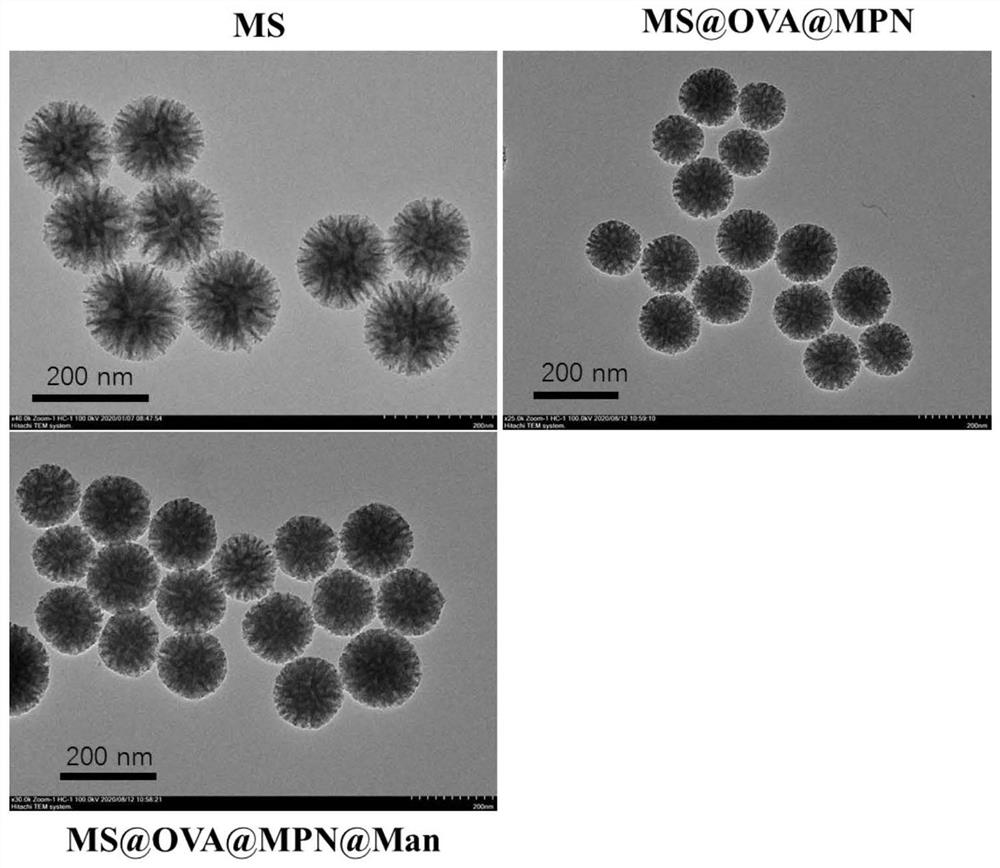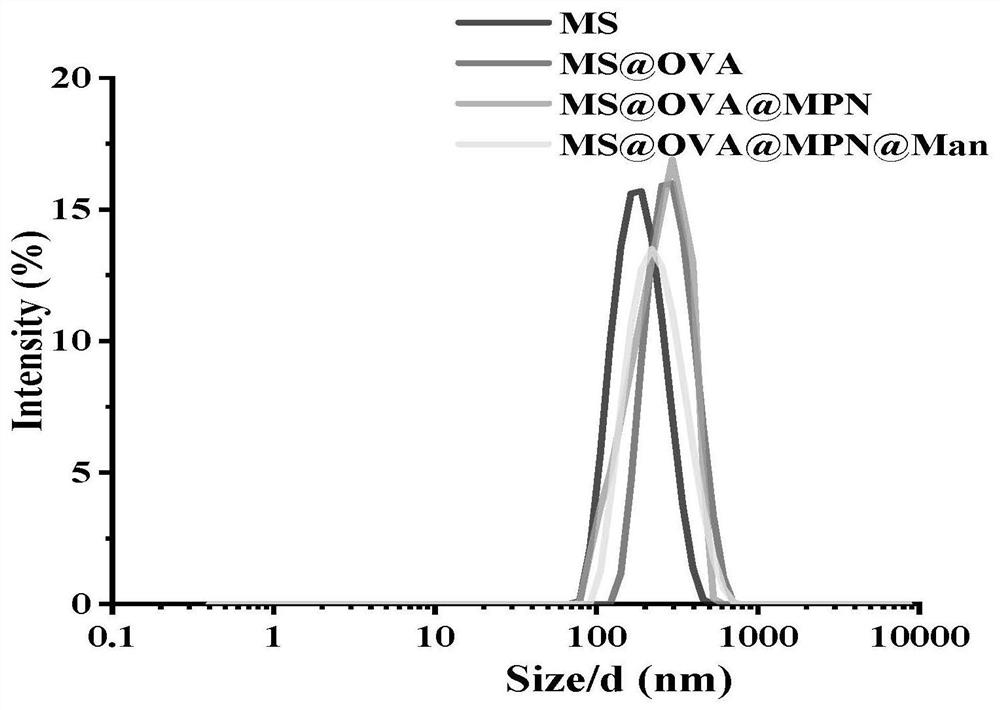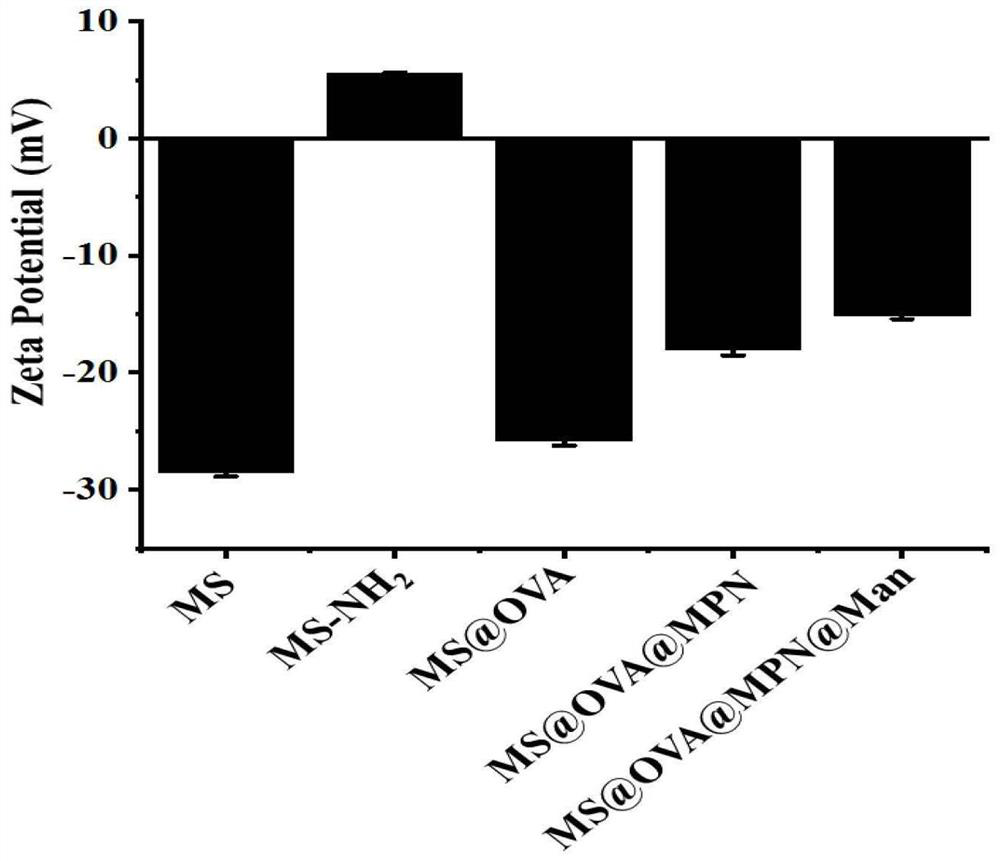Targeted nano-vaccine preparation based on metal-polyphenol network structure and product of targeted nano-vaccine preparation
A network structure and nano-vaccine technology, applied in the field of targeted nano-vaccine preparation and its products, nano-vaccine preparation and its products, can solve the weak response of antigen-specific cytotoxic T lymphocytes and increase the escape function of nano-particle lysosomes , affecting biocompatibility and in vivo safety and other issues, to achieve the effects of enhancing cellular uptake, improving targeting and lysosomal escape efficiency, and improving vaccine delivery efficiency
- Summary
- Abstract
- Description
- Claims
- Application Information
AI Technical Summary
Problems solved by technology
Method used
Image
Examples
Embodiment 1
[0043] Example 1: Synthesis of mesoporous silica nanoparticles (optimization of conventional preparation methods in literature)
[0044] According to the synthesis method disclosed in the literature, mesoporous silica nanoparticles with a preset particle size of about 110 nm were synthesized.
[0045] First, weigh 960 mg of cetyltrimethyl-p-toluenesulfonium ammonium (CTAT) into a round bottom flask, and add 50 mL of deionized water to dissolve it. At the same time, 174 mg of triethanolamine (TEA) was added to dissolve and mix well. The temperature of the oil bath was kept at 80° C. and stirred for 1 h, 7.81 mL of tetraethyl orthosilicate (TEOS) was slowly added dropwise, and the stirring was continued for two hours. The obtained product was washed three times with water and three times with ethanol (centrifugation condition: 13000g, 10min). Then the product was dried in an oven at 60°C for 12 hours. Grind it with a mortar and keep it in a muffle furnace for 6 hours at 600°C...
Embodiment 2
[0046] Example 2: Synthesis of mannose-modified tannic acid molecules
[0047] Weigh 3.25mg of aminated mannose (purchased from Sigma) and 20mg of tannic acid, then dissolve the two compounds in 5mL of MOPS buffer solution with pH=8.5, stir magnetically for 12h, and use a dialysis bag with a molecular weight of 700K Dialysis to obtain mannose-modified tannic acid molecules.
Embodiment 3
[0048] Example 3: Amination of Mesoporous Silica Nanoparticles
[0049] Accurately weigh 30 mg of mesoporous silica nanoparticles, dissolve them in 900 μL of ethanol solution, and ultrasonicate for 2 min to uniformly disperse the mesoporous silica nanoparticles in the ethanol solution, then slowly add 50 μL of ammonia water. Add 30 μL of 3-aminopropyltriethoxysilane (APTES) under the condition of vortexing, vortex for 30 s after the addition, and place in a closed reaction vial for overnight magnetic stirring.
[0050] The solution after the overnight reaction was centrifuged at 8000r / min for 5min, the precipitated particles were washed 3 times with methanol, and then washed 3 times with water to obtain aminated mesoporous silica nanoparticles, which were stored at 4°C for characterization and subsequent experiments.
PUM
| Property | Measurement | Unit |
|---|---|---|
| particle diameter | aaaaa | aaaaa |
Abstract
Description
Claims
Application Information
 Login to View More
Login to View More - R&D
- Intellectual Property
- Life Sciences
- Materials
- Tech Scout
- Unparalleled Data Quality
- Higher Quality Content
- 60% Fewer Hallucinations
Browse by: Latest US Patents, China's latest patents, Technical Efficacy Thesaurus, Application Domain, Technology Topic, Popular Technical Reports.
© 2025 PatSnap. All rights reserved.Legal|Privacy policy|Modern Slavery Act Transparency Statement|Sitemap|About US| Contact US: help@patsnap.com



